Oct. 14 update on COVID-19 in MN: Highest death count in months; 1,200 new cases

Go Deeper.
Create an account or log in to save stories.
Like this?
Thanks for liking this story! We have added it to a list of your favorite stories.
Updated: 2:22 p.m.
Minnesota’s latest COVID-19 data continues to show the state’s numbers headed in the wrong direction.
The Health Department Wednesday reported more than 1,200 newly confirmed cases, extending more than a weeklong trend of newly confirmed cases averaging more than 1,000 a day. Hospitalizations are also trending higher. The daily death count was the highest in months.
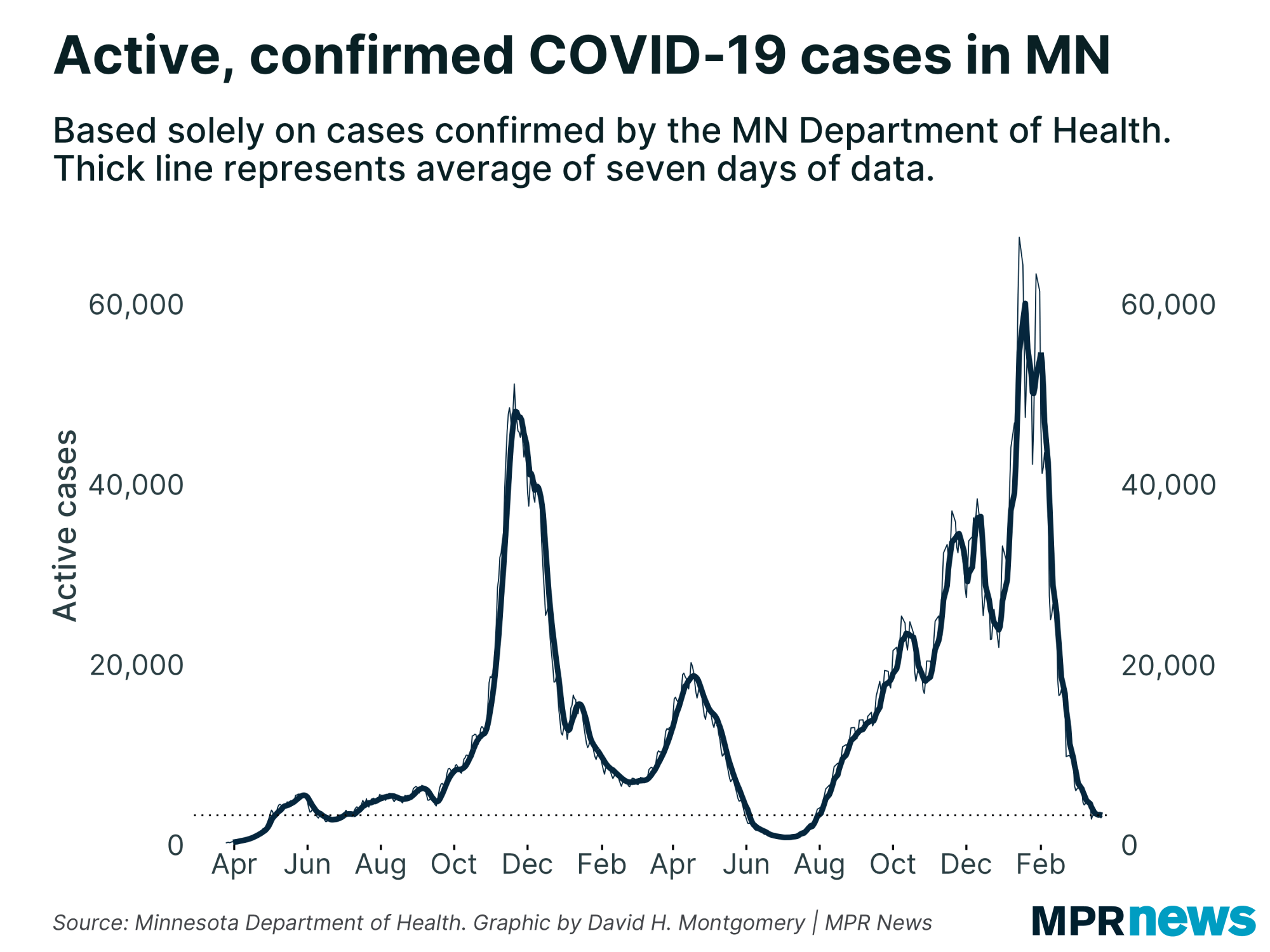
While daily new case confirmation numbers have ebbed and flowed during the pandemic, “the lows are getting higher and the highs are getting higher,” Kris Ehresmann, the state’s infectious disease director, told reporters Wednesday.
She described the current situation as an “escalating roller coaster,” adding, “I would not say that we have reached any sort of peak at this point.”
Turn Up Your Support
MPR News helps you turn down the noise and build shared understanding. Turn up your support for this public resource and keep trusted journalism accessible to all.
Officials on Wednesday also unveiled new changes to the way they report data on cases and deaths. They’ve begun reporting the results of antigen tests, a more rapid form of COVID-19 test, along with the results from the more traditional COVID-19 test known by its initials PCR.
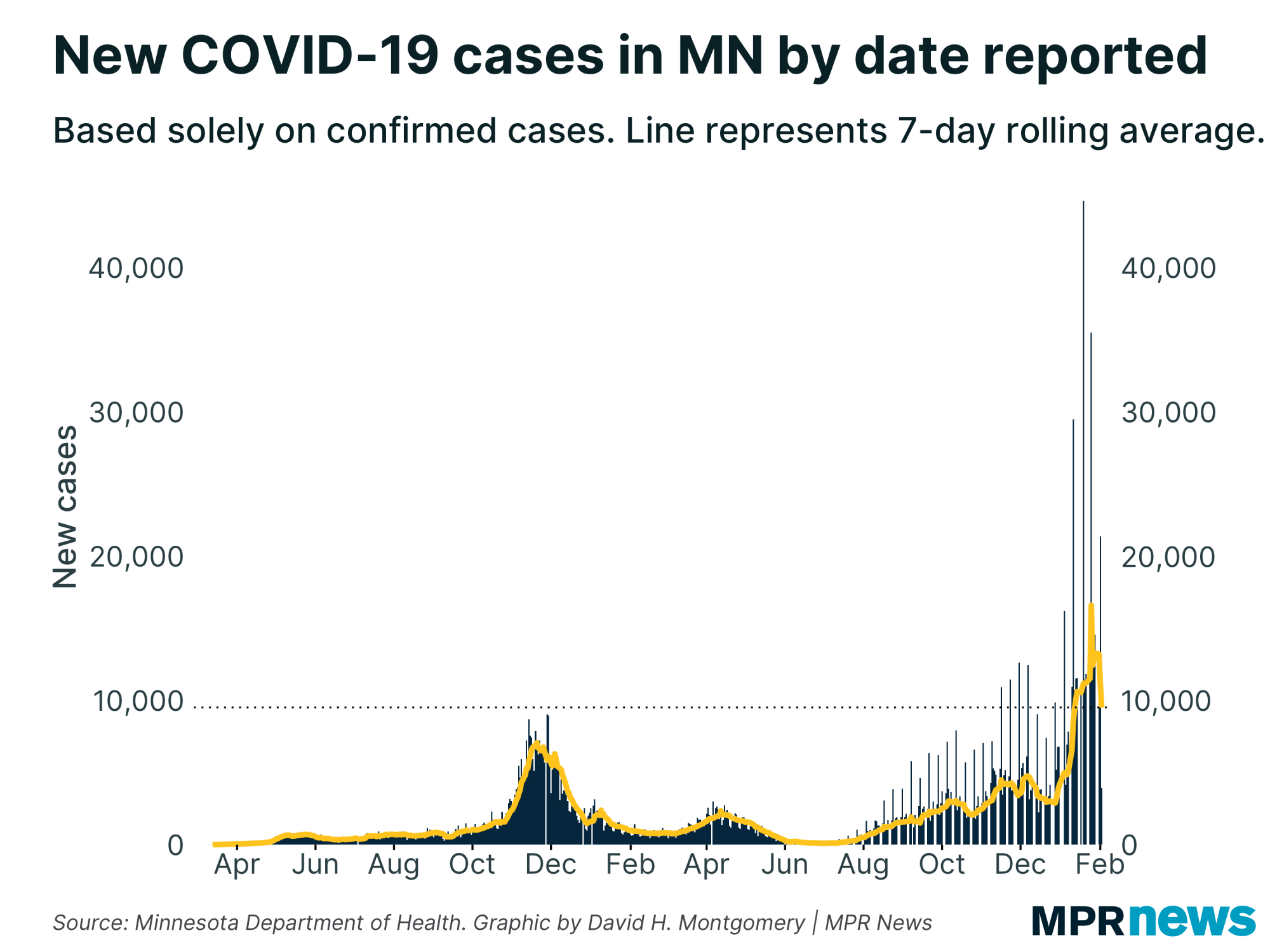
The Health Department said it made the move so its reporting would align with federal guidance. Antigen testing had been relatively small prior to this, so the change to previous case counts won’t be dramatic.
The state, though, is now adding to the COVID-19 death toll people who died after having had COVID-19 confirmed by an antigen (rapid) test but not a PCR test. That adds six people to the state’s death toll — on top of 23 newly reported deaths.
Even without the statistical tweak, it was still the highest number of daily deaths reported since mid-June. The jump follows similar spikes Wisconsin, which reported 34 deaths in its Tuesday report. North Dakota set a new record for daily deaths last week, at 24.
Those 29 deaths raised Minnesota’s toll to 2,180. Among those who’ve died, about 70 percent had been living in long-term care or assisted living facilities; most had underlying health problems.

The 1,254 newly confirmed COVID-19 cases reported Wednesday brought the total in the pandemic to 115,943 cases to date; about 90 percent have recovered to the point they no longer need to be isolated.
‘Widespread transmission’
Officials had anticipated seeing an October surge in cases expected from Labor Day weekend gatherings, sporting events and college student meetups at the start of fall semester. They also expected the wave would put more people in the hospital. That appears to be happening.
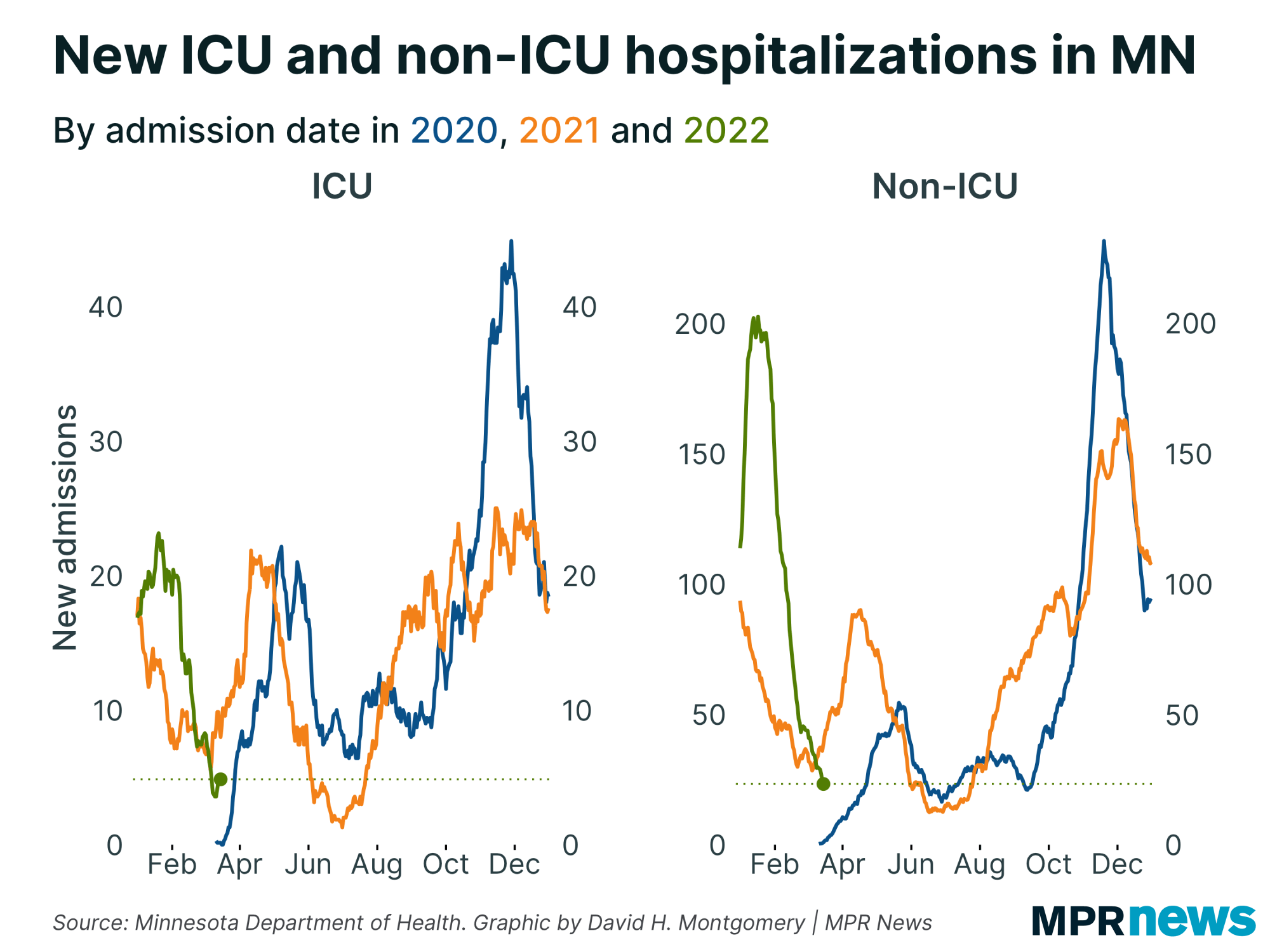
While the spike early in the pandemic was driven largely by illnesses tied to long-term care facilities and workplace sites such as meatpacking plants, officials say the current spread is diffused, making it even harder to trace and isolate cases.
“We’re seeing this widespread transmission in the community. That’s what’s really concerning,” Ehresmann said Monday.
The positive test rate trend remained above 5 percent, the threshold where officials become concerned.
The newest numbers came a day after state officials unveiled plans to massively expand COVID-19 testing opportunities across Minnesota as active caseloads remain at record highs and hospitalizations continue to climb.
Collectively, Minnesota will soon be able to process 60,000 tests per day, officials said, about twice what it’s managed on its best days to date.
“The biggest thing we can do to ensure our kids have an opportunity to be in school, that our businesses and restaurants remain open, is to simply follow the science around masking, around social distancing, getting tested,” Gov. Tim Walz told reporters Tuesday. “To not do these things will guarantee that others get it.”
Concerning rise in cases among senior Minnesotans
New cases are up dramatically over the past month in all age groups. That includes a concerning rise in the number of new cases among Minnesotans ages 60 and older. It’s not clear what’s behind those increases.
People in their 20s still make up the age bracket with the state’s largest number of confirmed cases — more than 26,000 since the pandemic began, including more than 15,000 among people ages 20-24.
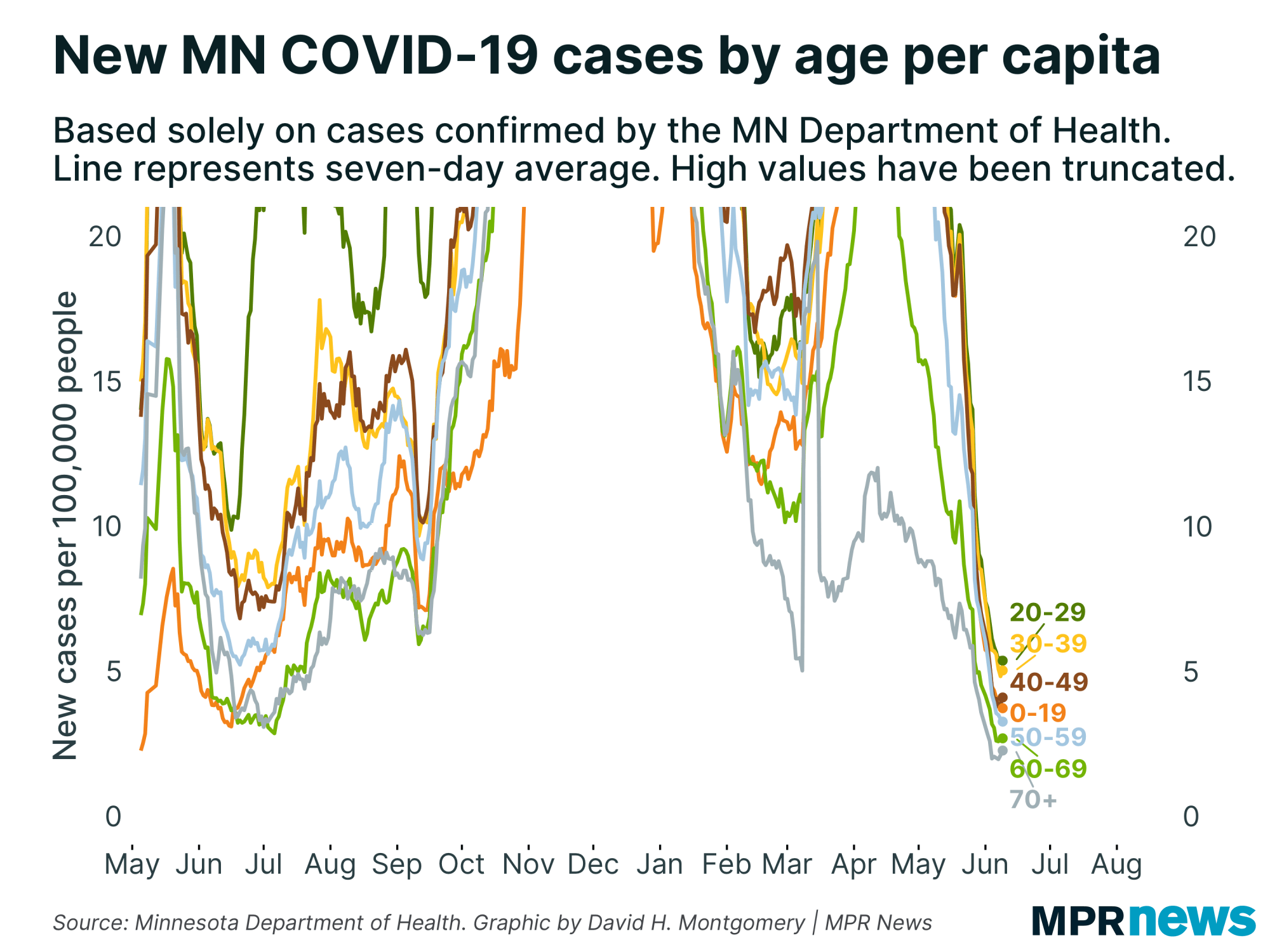
The numbers help explain why experts remain particularly concerned about young adults as spreaders of the virus.
While less likely to feel the worst effects of the disease and end up hospitalized, experts worry youth and young adults will spread it to grandparents and other vulnerable populations and that spread could hamper attempts to reopen campuses completely to in-person teaching.
The number of high school-age children confirmed with the disease has also grown, with more than 10,800 total cases among children ages 15 to 19 since the pandemic began.
Cases surging outside the Twin Cities metro area
Regionally, central, northern, southern Minnesota have driven much of the recent increase in new cases while Hennepin and Ramsey counties show some of the slowest case growth in the state.
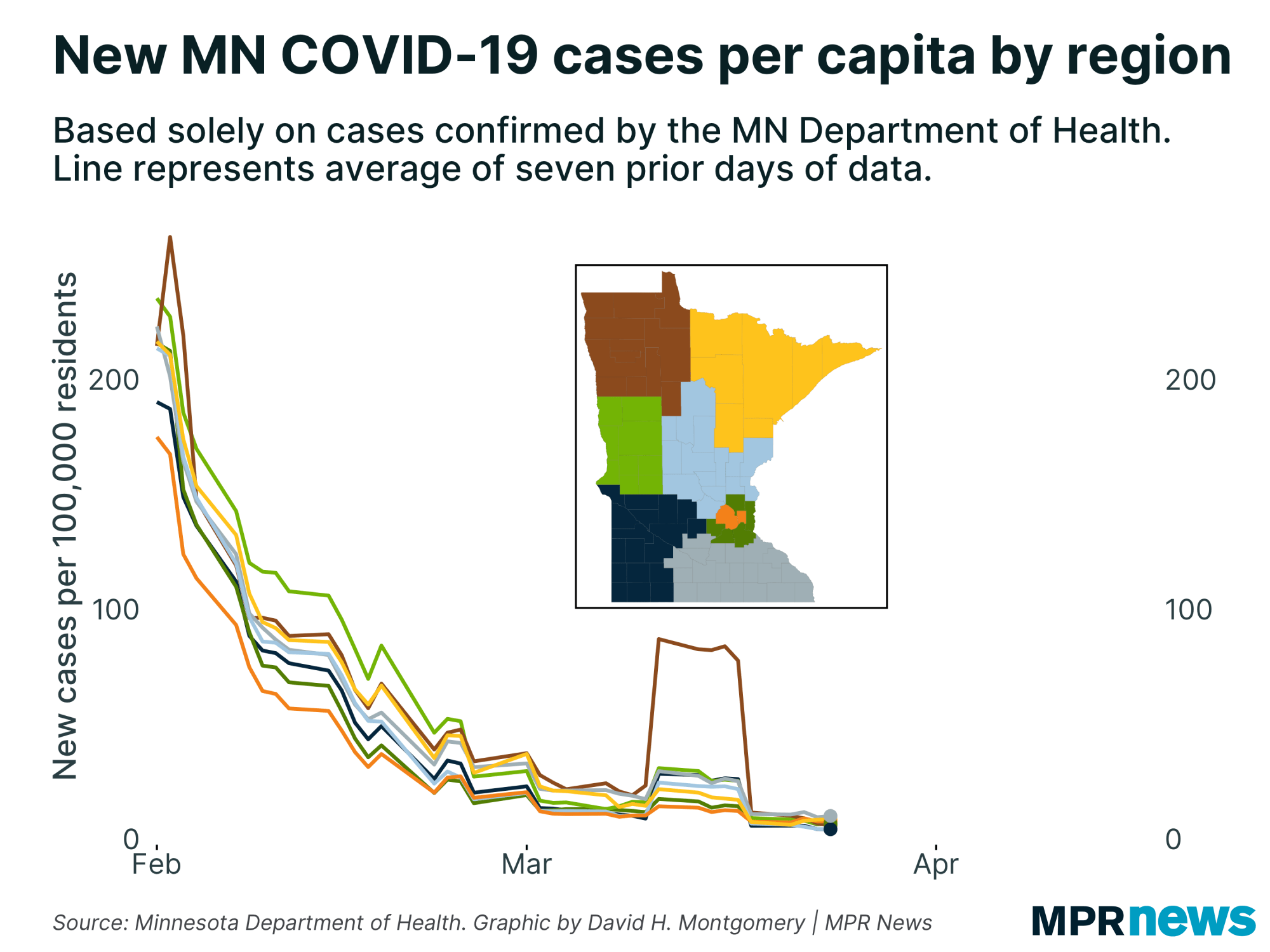
Central Minnesota cases are skyrocketing relative to its population. It’s not clear why. Northern Minnesota, once by far the region least affected by the disease, has also seen its caseload grow dramatically in recent weeks.
Collectively, rural areas of Minnesota continue to report the most new COVID-19 cases.
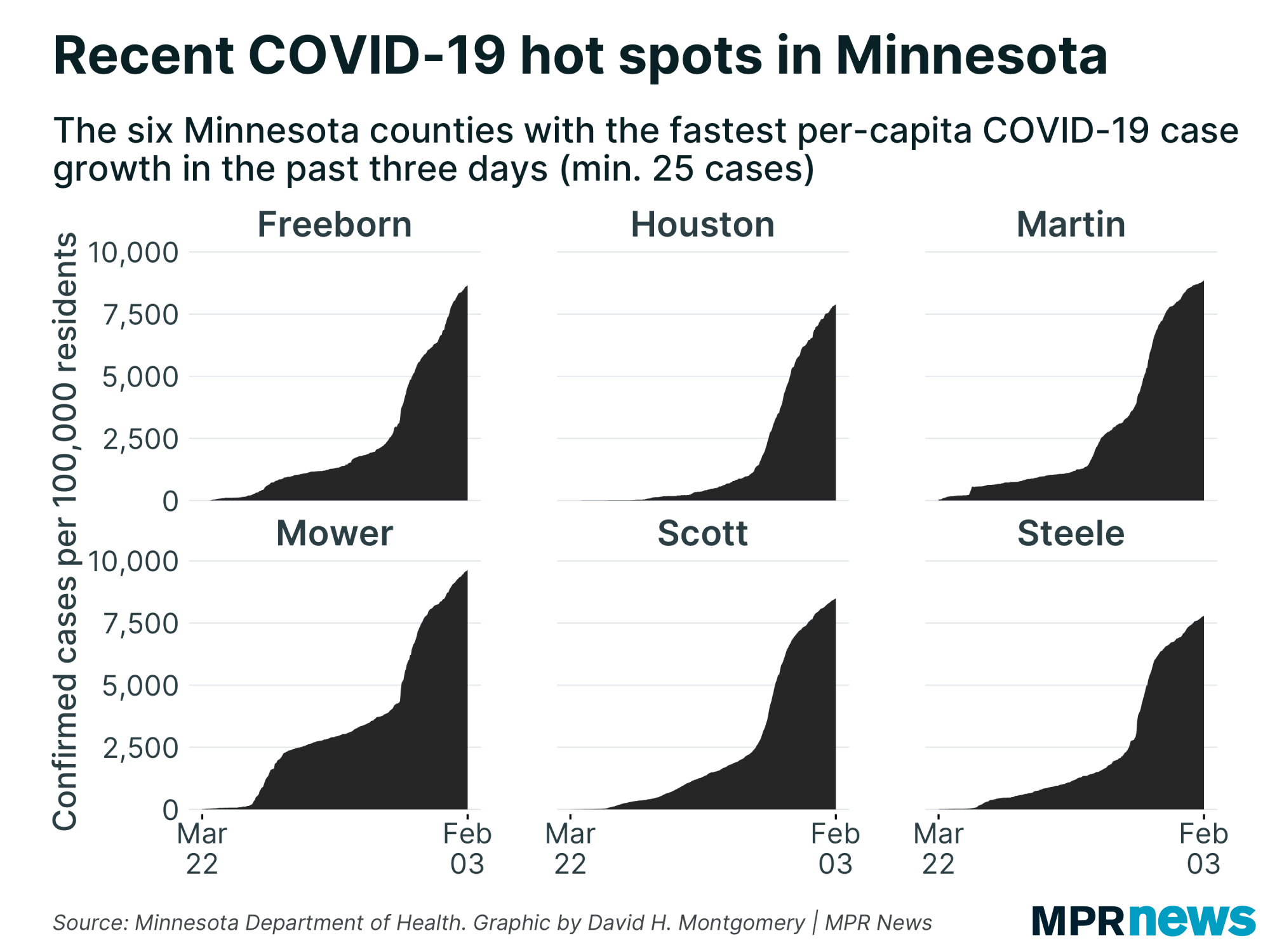
Early on, many Minnesotans thought COVID-19 would be only a Twin Cities metro area problem, but now the biggest problems are happening outside the suburban and urban parts of the state.
“The hottest of our hot spots are outside the metro area,” Ehresmann said Friday. That includes Martin and Pipestone counties in southern Minnesota, where positive test rates are hitting 10 percent, about twice the statewide average.
Ehresmann implored Minnesotans again to wear masks in indoor public gathering spaces, socially distance and stay home if they don’t feel well. “People in greater Minnesota,” she added, “they have it within their control to make things better.”
Curbs eased for long-term care facility visits
Minnesota health officials on Monday put out new guidance to ease visiting rules for nursing homes and other long-term care facilities in the state.
Visitors must now be allowed if the long-term care facility has not had a COVID-19 exposure in the last 14 days. Another requirement for opening nursing homes is if there's low to medium virus transmission in the county.
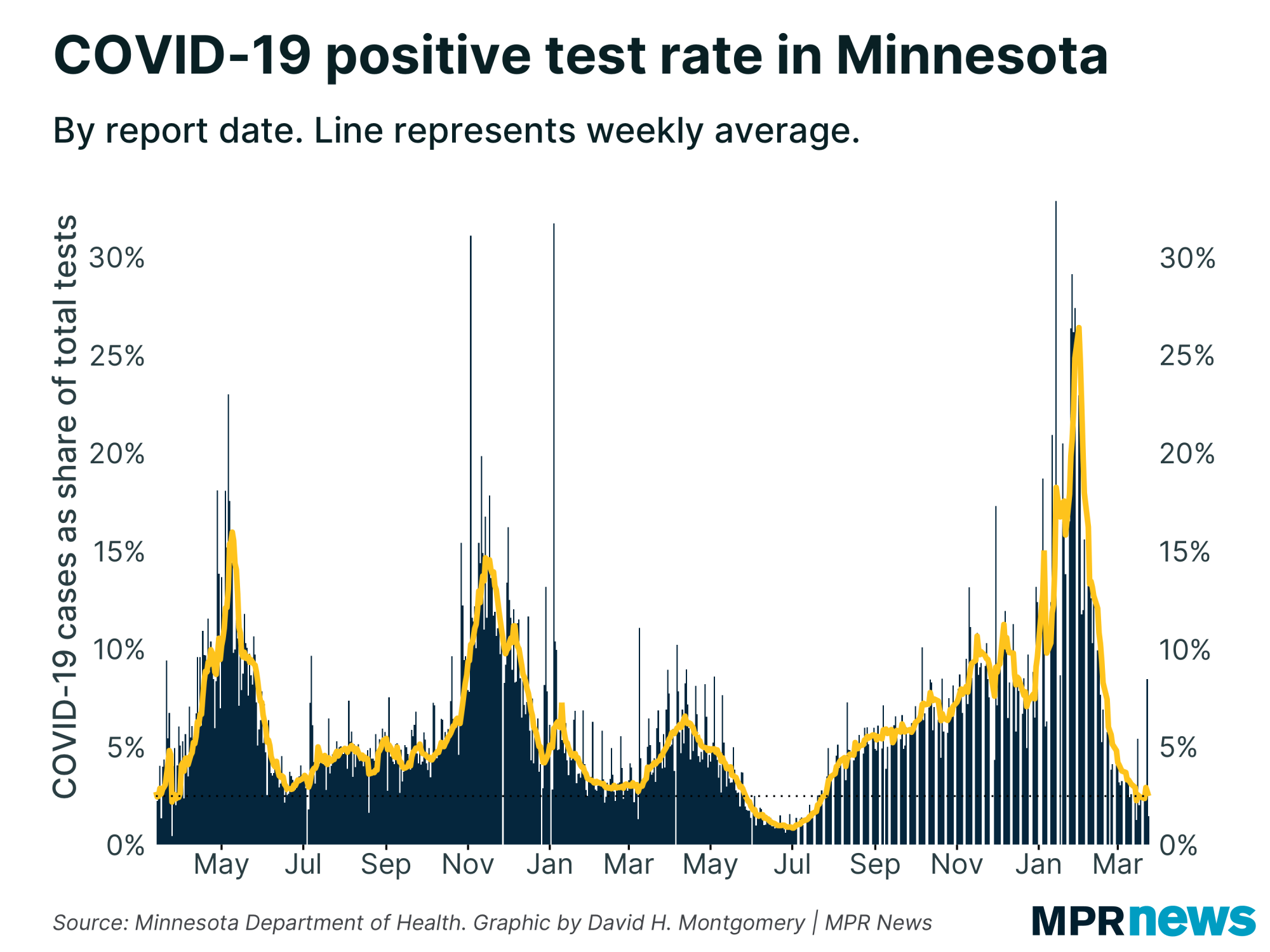
There are exceptions if there is a reasonable or clinical safety cause not to open, such as staffing issues.
The new rules go into effect Saturday. They are being introduced to align with new federal recommendations. Visitors still must schedule their time with the facilities, be screened for symptoms and wear masks.
Long-term care settings have long been a deep concern for the state’s public health authorities. Among the 2,144 who’ve died from COVID-19 related complications in Minnesota, about 71 percent had been living in long-term care or assisted living facilities; nearly all had underlying health problems.
Officials had placed severe visiting restrictions early on in the pandemic, hoping to stem the spread of the disease. They’ve also acknowledged the psychological toll that takes on residents and their families.
Latino cases jump; racial disparities persist
In Minnesota and across the country, COVID-19 has hit communities of color disproportionately hard in both cases and deaths.
Minnesotans of Hispanic descent are testing positive for COVID-19 at about five times the rate of white Minnesotans. They, along with Black Minnesotans, are also being hospitalized and moved to intensive care units at higher rates than the overall population.
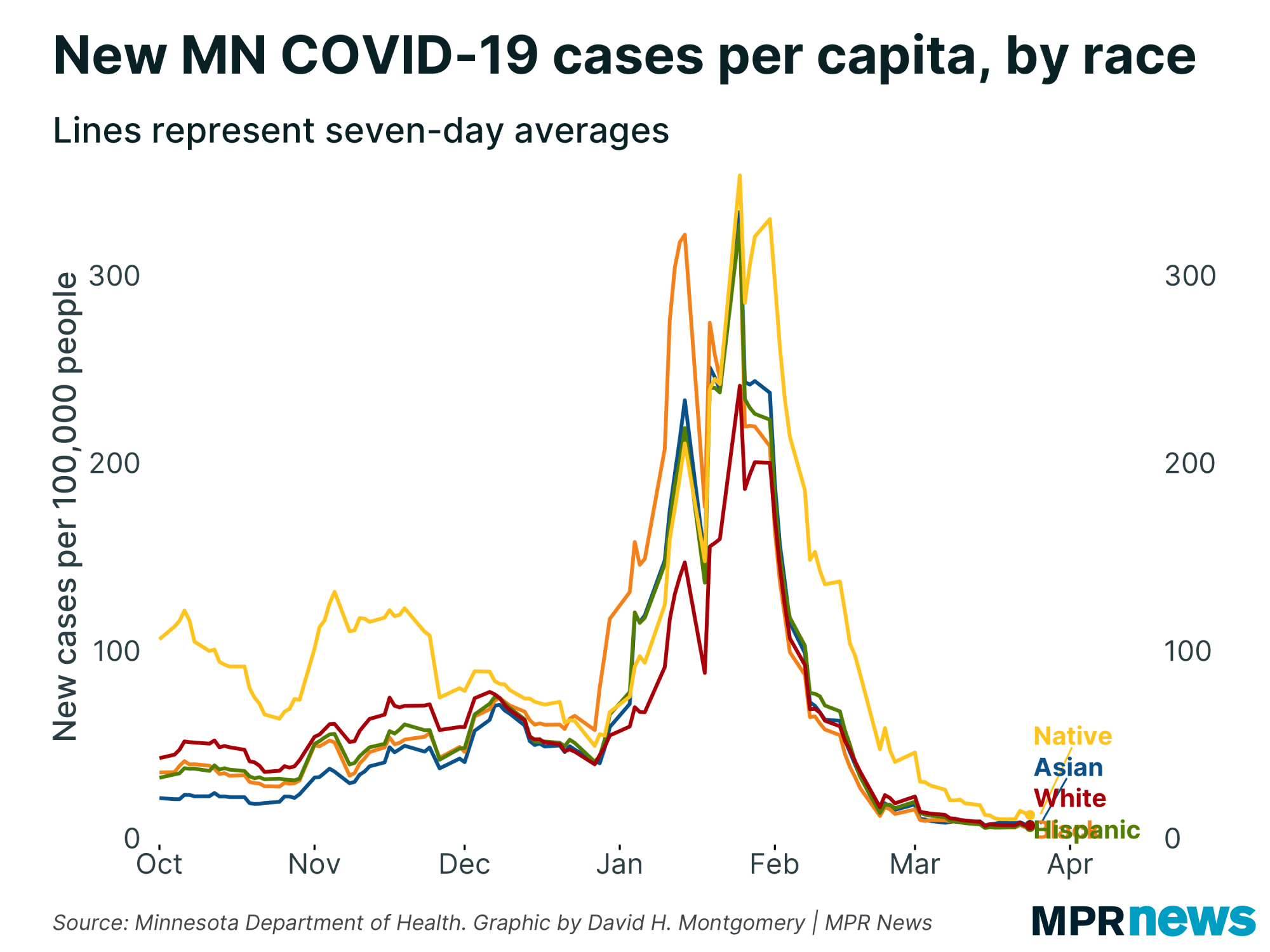
Similar trends hold true for Minnesota’s Indigenous and Asian residents.
The newest numbers, though, show newly confirmed cases accelerating among Latino people in Minnesota.
Distrust of the government, together with deeply rooted health and economic disparities, have hampered efforts to boost testing among communities of color, particularly for unauthorized immigrants who fear their personal information may be used to deport them.
Developments around the state
Another Walz recall attempt fails
A third effort aimed at removing Gov. Tim Walz from office has been tossed out. The Minnesota Supreme Court dismissed the latest recall petition in an order signed Monday by Chief Justice Lorie Gildea.
The voters who brought the recall petition argued that Walz overstepped his power with a statewide mask use mandate designed to limit the spread of coronavirus. They said it conflicted with a state law barring people from concealing their identity in public unless it is tied to protection from weather, religious beliefs or medical treatment.
Gildea’s order doesn’t reach a conclusion about whether the mandate is legal or not. But the chief justice said either way “the proposed petition does not allege facts that, if proven, would constitute malfeasance” required under the recall law. The prior recall attempts were turned back in May and July.
— Brian Bakst | MPR News
U of M eases COVID-19 restrictions at Twin Cities campus
The University of Minnesota, Twin Cities has moved into it's third stage of its plan for safely bringing students back to campus.
The school's four-stage “Maroon and Gold Sunrise Plan” limited the movement and interactions of students living in campus housing during their first weeks on campus.
During the first stage, students were in their residents halls almost exclusively. And during the first and second stage, there was a 9 p.m. curfew.
The campus is now moving into stage three, meaning students have full access to campus and the surrounding community. But they have a midnight curfew to be back in the dorms.
The third stage will last about two weeks. The fourth and final stage, is "COVID-19" normal, meaning there are no back home time constraints, though students must avoid large gatherings, maintain physical distancing and wear masks, as they've had to do at all other stages.
— Peter Cox | MPR News
90 inmates at Stillwater state prison contract COVID
The state prison in Stillwater is on lockdown after 90 inmates tested positive for COVID-19.
Routine mass testing this week found 90 new COVID-19 infections at the prison, bringing its total number of cases to 115, the Department of Corrections says.
The department says the inmates with confirmed cases either have no symptoms or are mildly symptomatic. However, a 70-year-old man is receiving medical attention outside the prison.
The department says in a statement that all but two of the men who tested positive reside in the Cell Hall D and Atlantis living units.
— Matt Sepic | MPR News
More free testing sites open this week
The Minnesota Department of Health and local officials are offering another round of free COVID-19 testing sites around the state this week.
Testing sites will be open Wednesday and Thursday in Aitkin, Alexandria, Anoka, Faribault, Luverne and St. Cloud.
Testing also will be available Thursday and Friday afternoons at New Hope Baptist Church in St. Paul.
For more details on times and testing locations — and to sign up for an appointment — go to the MDH website.
State health officials also announced that they're opening a second COVID-19 saliva testing site later this week, in Winona.
The state opened its first saliva testing site in Duluth late last month. The second site will open Wednesday at the Winona Mall.
Health Department officials say they are trying to be proactive as COVID-19 cases continue to surge around the state. They say that they're especially concerned about a growing spread of the coronavirus throughout greater Minnesota.
Saliva testing will be available to anyone who wants it or thinks they need it. So far more than 7,000 people have completed saliva testing at the first site in Duluth. State officials plan to open as many as eight more sites across the state in the coming weeks.
The Winona testing site will be open five days a week, from Wednesday through Sunday. Find more information here.
— MPR News Staff
Top headlines
Close-knit St. John’s monks seek space to stay safe in pandemic: The monks share close quarters. They eat together three times a day and pray together four times a day. And many are still actively involved in teaching and ministry outside the abbey — at the university or in local parishes. When COVID-19 arrived, their close-knit community and collective way of life meant their most vulnerable members would be at risk.
Walz says loosening restrictions about 'striking a balance' between data, follow-through: The gobernor said he’s well aware that Minnesota is taking steps to relax precautions against spreading COVID-19, even as the pandemic widens in the state.
Minnesota to allow more visits to nursing homes, long-term care facilities: More people soon will be able to visit loved ones in nursing homes and other long-term care facilities. The Minnesota Department of Health says the changes are set to go into effect on Saturday.
COVID-19 in Minnesota
Data in these graphs are based on the Minnesota Department of Health's cumulative totals released at 11 a.m. daily. You can find more detailed statistics on COVID-19 at the Health Department website.


